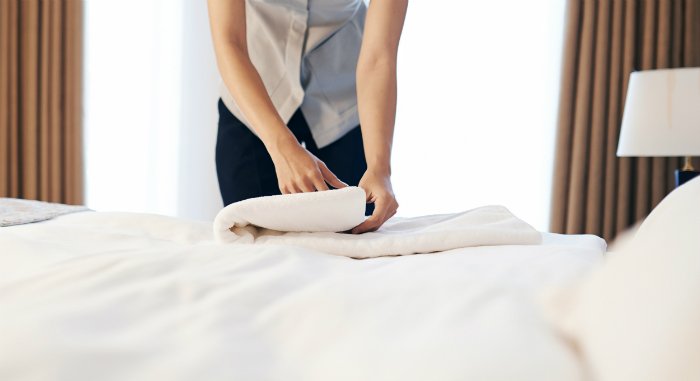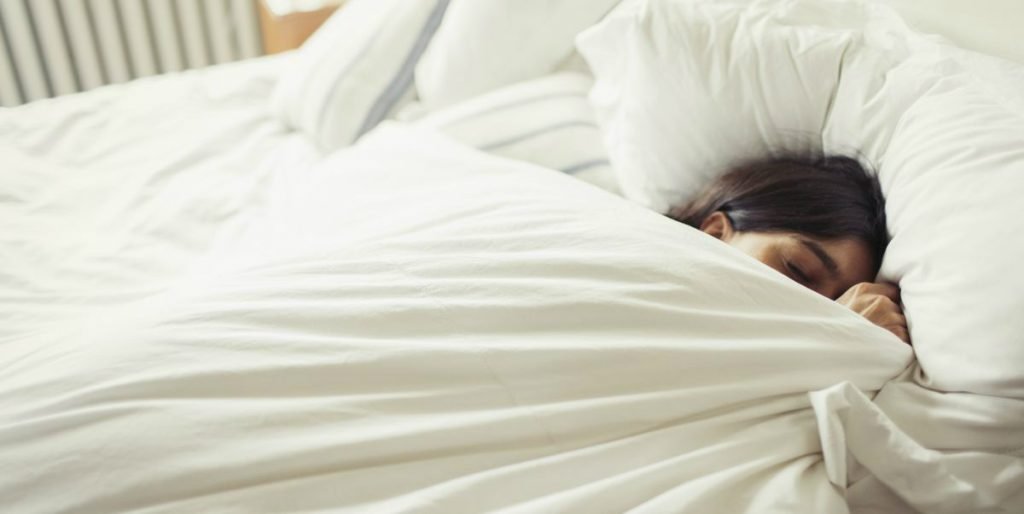What Are Bamboo Sheets Made Of? Everything You Need to Know
2Shares
Bamboo sheets have taken the market by storm. It has a promise of comfier and more breathable sleep as compared to conventional fabrics. But what are bamboo sheets made of that makes it so unique? In this post, we will dig through bamboo fabrics and how it’s made. Also, we will discuss with you the benefits of bamboo against other fabrics that you have at home.
What are bamboo sheets made of?
Bamboo sheets are fabrics made from bamboo fiber. It could either be rayon or viscose, lyocell, and modal. Each one has a specific characteristic and feel.

*Rayon
Bamboo rayon or viscose is the most common fiber used for the production of bamboo sheets. It’s the first generation of the cellulosic fibers derived from the bamboo plant. It’s breathable and comfy to use. However, you have to choose one that’s processed without using chlorine or bleach.
The good thing about rayon is it doesn’t have any insulation properties. This is the same reason why it suits hot sleepers and those who prefer to use bamboo sheets during the summer months.
*Modal
Next, we have the second generation fabric called modal. This is extra soft and bears the high-wet strength, making it machine-washable. It’s also safe to tumble dry. In addition, modal bamboo fabric is usually used for clothing and outerwear.
Also, the modal bamboo fabric has a brighter color. It doesn’t gray quickly, as compared to cotton. In fact, the production of modal doesn’t require bleaching. Aside from that, the smooth surface of modal fabric makes it less likely for minerals to deposit into it. This is why it’s a great bedding sheet for areas with hard water.
*Lyocell
Moreover, the lyocell bamboo fabric is made by dissolving raw bamboo into a non-toxic solvent. Water is then added into it during the recycling and reusing process. With the additional processes, lyocell becomes softer and stronger than rayon. It’s also more absorbent and acts as a protective layer to regulate body temperature.
What sets lyocell apart from the two other types of bamboo fabric is the nanofibrils. It’s a highly water-absorbent component that makes it ideal in absorbing sweat and other fluids. In fact, lyocell bamboo fabric is 50% more absorbent than cotton and wool.
Cotton sheets vs. bamboo sheets
Many bamboo sheet buyers would always compare bamboo fabric to cotton in terms of softness. If you’re torn which one to buy, you may consider the following differences.
First of all, bamboo sheets can be softer, depending on which type of fabric you’ll choose (see above). It’s also more durable than cotton.
However, bamboo fabrics can be a bit demanding in terms of maintenance. Not all bamboo sheets can be machine-washed or tumble-dried.
Bamboo sheets are more eco-friendly…
Still, that’s only a small issue and forgivable, to say the least. If you’re an environment geek, you’ll be glad to know that bamboo is more eco-friendly than cotton. The former uses only a third of the water that cotton consumes. Aside from that, bamboo doesn’t need tons of pesticides as cotton does. This makes bamboo a better option than cotton for those who have intense allergies.
Nevertheless, the downside of bamboo goes during winter. It’s not as heat-retaining as cotton, which makes it more of a summer season option.
The cost is quite a gray area as both can be affordable and expensive, depending on the set that you’re going to buy.
Linen vs. bamboo sheets
Both linen and bamboo fabrics are derived from plants. The linen fabric came from the fibers of the flax plant, usually found in the European region, mostly in Belgium.
Also, linen is heavier than cotton and bamboo. Still, it’s almost as durable as bamboo and will last just as long. This is why linen is the common choice for drapes and other areas that require thick fabric.
If we are to compare, bamboo sheets stand out in terms of durability. Still, we can say that linen isn’t a total goner as it’s way durable than cotton.
Another thing is that both bamboo and linen are comfortable to use. The only difference is that linen sheets need a ‘break-in’ period as it comes off crisp straight from the package.
However, if you’re a hot sleeper and you’re looking for a breathable bed sheet, you’re better off using bamboo sheets. Linen usually runs thick and can be a little hot during summer days. Still, linen comes handy during winter.
Benefits of bamboo sheets
Bamboo sheets have a lot of benefits: from its hypoallergenic characteristics to its eco-friendly production. To give you a better idea, here are more of the benefits of bamboo sheets:

*Durable
Unlike other fabrics, bamboo boasts of excellent durability. With proper washing, it can last for years of regular use. Also, sheets with long fibers are far more durable than cheap ones with shorter fibers.
Aside from that, bamboo has a stretchy characteristic that allows it to endure a little tugging if you share the bed with someone. It can also last hundreds of washes without losing its color and soft feel.
*Comfortable
Sheets made of organic bamboo fibers are soft and skin-friendly. It’s also highly breathable than other fabrics. If you’re looking for a bedsheet for the summer months, you’ll find a comfy choice with bamboo. It doesn’t trap excess heat underneath so you can stay wrapped and cozy.
*Eco-friendly
Bamboo fabrics consume less water and are grown with little to no pesticides. With that, you will also benefit since it has fewer allergens that may irritate you as you sleep. Also, it suits kids with sensitive noses and skin.
A few disadvantages
Just like any fabric, bamboo sheets have a few downsides. Still, it’s outweighed by the pros. To give you a better idea, here are some of the disadvantages of bamboo sheets that you may encounter:
*Cost
Unlike traditional sheets, bamboo fabrics have a higher price tag. This is due to the organic and eco-friendly production. As much as you can find cheap options, it’s not as durable and comfortable to use than premium sets.
Nevertheless, every cent is worth it once you’re using your bamboo sheets. It’s comfy and definitely cozy in the bedroom.
*Maintenance
Owners of bamboo sheets will agree that this fabric requires more attention than other types. Not all bamboo sheets are safe to tumble dry. Also, it should only be washed in a gentle cycle and in cold water. Aside from that, you can’t wash them with towels as the bamboo fabric will get all the lint.
Bamboo thread count
One thing that buyers of bamboo sheets check is the thread count of the product. But does it really matter?
Well, the fact is that high-thread fabrics are stiffer and low-thread ones are softer. Basically, bamboo sheets can be found with 200 to 800 thread counts. However, the numbers can be as high as 1000 for thicker sets.
If you want a dense bamboo sheet that has a fine weight, you’re better off looking for one with a thread count of 400 to 500. Meanwhile, for silky soft ones, a maximum thread count of 300 is a rule of thumb.
How to wash a bamboo sheet
Bamboo sheets require a special way of washing to retain its softness and durability. Also, this is necessary to prevent lint from forming. For starters, the following steps can be a good start:
Tip #1. Wash it in cold water
It’s ideal to wash bamboo sheets at a maximum of 30C and in the gentlest cycle possible. Do this regardless if you have new or old sheets.
Tip #2. Don’t mix it with other textiles.
The thing with bamboo sheets is it can’t cycle on the wash with other fabrics. It tends to attract lint, which could make it unsightly. Also, the zippers and hooks of clothing can cause abrasions and tears, which will lead to more lint.
Tip #3. No need for fabric softener
Bamboo sheets are naturally soft, so there’s no need to use a fabric softener on this one. If you want a nice smelling sheet, you can use a good-smelling detergent or blend mild essential oils into the wash.
Tip #4. Dissolve the detergent powder first
If you’re washing with powdered detergent, make sure that it has dissolved first before soaking the sheets. This is to prevent clumping of the detergent, which will lead white and unwashed suds on the bamboo fabric.
Tip #5. Never wash with bleach
Bleach will ruin the color and durability of your bamboo sheets. If you got stains to remove, look for a gentler solution. Unless you’re willing to have discolored spots, it’s best to use a mixture of vinegar and water.
Final words
What are bamboo sheets made of? It can either be rayon, modal, or lyocell fabric. All of these are derived from the bamboo plant and bear different characteristics. Although bamboo fabrics have a higher price tag than budget sheets, it’s a great and comfy investment that will last for years.
Do you have something to add to our post? Share it with us in the comment section!
2Shares
